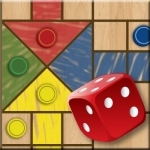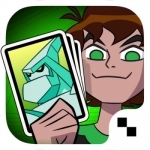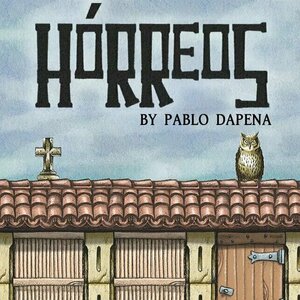
Boom Beach
Games
App
Welcome to Boom Beach: come with a plan or leave in defeat! Fight the evil Blackguard with brains...

Teenage Mutant Ninja Turtles: Battle Match Game
Games
App
The Triceratons have destroyed present day Earth! Help the Teenage Mutant Ninja Turtles travel back...
Purple Phoenix Games (2266 KP) rated Arctic Scavengers in Tabletop Games
Jun 12, 2019
Welcome to the Ice Age. No, not the animated movie. I’m talking about the real deal. Arctic Scavengers is set in a post-apocalyptic ice age where the cold is deadly and the resources are scarce. Any surviving humans have banded together to form ‘tribes’ that are competing for dominance in this frigid tundra. Can you and your tribe outwit your competitors to become the most powerful group? Or will a bigger and more menacing tribe overpower you and jeopardize your survival?
Disclaimer: The solo variant is only addressed in the Recon Expansion rules. There IS another expansion – HQ – but I have not used that content in my solo plays. This review only encompasses the Base Game and Recon Expansion.
Arctic Scavengers is a deck-building game where players are recruiting mercenaries to their tribes, searching for general resources, and battling other tribes for contested resources. Each turn has two main phases – Resource Gathering and Skirmish. During Resource Gathering, you play cards from your hand to either recruit new mercenaries or search the junkyard for general resources. Any remaining cards in your hand are then used during the Skirmish phase – where the player with the highest ‘fight’ value wins the contested resource for that round. At the end of the game, the player with the biggest tribe wins!
The solo variant has some minor differences, but is played essentially the same way. In a solo game, the contested resource cards are divided into 7 skirmishes to be encountered throughout the game. You can decide when to engage in a skirmish – it is not a requirement to encounter one each turn. After each skirmish, you either win and earn a contested resource, or lose and must permanently discard a card from your losing hand. The game ends when all 7 skirmishes have been encountered. The other difference is that each time you have to re-shuffle your discard pile, you must permanently remove the top card of your new deck from the game. Beyond those changes, the game remains the same. At the end of the game, all cards in your tribe are worth certain numbers of points – the goal is to beat your own personal best score.
In theory, this game sounds super cool! But when I actually got to play it solo, I was seriously underwhelmed. The game feels stagnant in the sense that there is no tension or urgency in your strategy. Since YOU get to decide when to engage in a skirmish, it is possible to just while away the time building up your deck until you have enough cards to beat every skirmish. Yes, you permanently discard a card each time you re-shuffle your discard pile, but if you are able to recruit one or two new cards each turn, it negates the penalty of discarding a card. The ability to choose when to engage in skirmishes is seriously over-powered because there is nothing stopping you from ignoring skirmishes and amassing cards for end-game scoring.
The other grievance I have with the game is regarding the Junkyard – the deck of cards where you ‘search’ for resources. The solo rules do not explicitly address setting up the Junkyard deck at all. So do you use one or not? Not having the Junkyard deck can be a serious hinderance – certain mercenaries cannot be recruited without certain resources. If you DO play with the Junkyard, how many cards do you use? Do you use the corresponding cards from the Base game and BOTH expansions? Only Base game and one expansion? Again, not explicitly addressed. I’ve tried using all of the Junkyard cards and that is difficult – there are just too many cards in that deck. I have gone entire games without coming across a necessary resource just because the size of the deck is too large (and I’m apparently a poor card-shuffler). The simple solution to this ambiguity would have been to just address it in the rulebook. But it’s not there, so I’m left guessing as to how I should set it up every time.
I really like the idea of this game. I really don’t like the solo variant though. Not having forced skirmishes makes the game extremely boring for me – I don’t really need a strategy since I can just recruit cards until I can draw a powerful hand. If there was a timeline for skirmishes – maybe something like “You must encounter one skirmish every other turn” – the game would be vastly different. I would actually need to strategize what cards to recruit and how I should delegate my cards on turns with a skirmish. In most games, I will reach a certain point where I choose to encounter a skirmish (that I know I will lose) just because I am starting to get bored. I appreciate the sentiment of including a solo variant, but this one just does not work.
Arctic Scavengers requires decent strategy and it offers good player interaction in group games. In a solo game, however, it is just imbalanced and boring. This is one solo variant that I would not recommend that you try, unless you are including drastic house rules.
https://purplephoenixgames.wordpress.com/2019/03/06/solo-chronicles-arctic-scavengers/

Classic Ludo Offline & Online
Games
App
NEW: Multiplayer Online with Facebook Friends available now. Calling all the kings of Ludo game,...
Purple Phoenix Games (2266 KP) rated Horreos in Tabletop Games
Jan 23, 2022
Hórreos is a 2-player game in which players are competing to build the most effective and aesthetically pleasing hórreo in town. What is a hórreo? It is a building for storing grain, elevated from the ground to prevent rodents from infiltrating the structure. So in this game, players are building long and ornate hórreos that not only look stunning, but can keep the rats out of the grain! To setup for a game, each player receives 2 Action cards and the Hórreo cards are shuffled. The deck is placed between the players, and the top card is placed beside the deck to form a 2-card Market. The Leader card is placed beside the Market, facing the starting player. Pictured below is the setup for the beginning of a game.
Over a series of rounds, players will be taking 1 of 4 possible actions as they attempt to build the highest-scoring structure. Each player has 2 Action cards at their disposal. Each Action card has 2 possible Actions on it – one card is Sabotage or Plan, the other is Steal or Build. Both players will secretly choose whichever Action they wish to perform this turn, and place their card face-down in front of them. Players will then simultaneous reveal their chosen Actions, and they will be resolved in the following order – Sabotage, Plan, Steal, and Build. If a player has chosen to Sabotage, they will rotate their opponent’s Action card, forcing them to perform the other listed action this round. To perform the Plan action, the player will select one of the cards from the Market to be placed into their personal supply tableau. If you have chosen to Steal, you will select a card from your opponent’s supply, and take it into your own supply tableau. And finally, to Build is to move a card from your supply to your hórreo. Cards in your hórreo cannot be stolen. As with many other ButtonShy games, cards in your hórreo may be placed adjacent to, or even overlapping, previously played cards – cards may never be tucked under cards in your existing hórreo.
If both players have chosen the same action, the player with the Leader card facing them gets to decide which player will resolve their action first. The Leader card is then rotated to face the opposite player, and so on, for future ‘ties’. An important note – you cannot pick the same Action twice in a row, you must pick one of the other 3 Actions. So take that strategic tidbit into consideration when deciding what to do each round! The game continues in this fashion, with players selecting/simultaneously revealing Actions, resolving their Actions in order, and building their hórreo until there is 1 or fewer cards left in the Market and the players’ supplies at the end of a round. At that point, the game ends, points are tallied, and the winner is declared!
Points are scored in several ways. Most of the hórreo cards are ‘decorated’ with crosses and pikes, and each pair you have in your final hórreo will earn you points. Similarly, the number of doors in your hórreo, as well as adjacent pillars supporting your structure, will earn you points dependent upon the number (the more doors you have, the more points you earn, etc.). As mentioned earlier, you’re trying to keep these pesky rats out of your grain, so any rat pictured on your cards is worth -2 points, but each owl you have pictured eats (cancels out) one rat. And of course, whichever player has build the longest hórreo earns extra points. All points are tallied, and the player with the highest score is the winner!
I have to admit that Hórreos surprised me. The gameplay seems simple enough, so I honestly wasn’t really expecting a lot from this game. For such a small game, Hórreos is all about strategy. Each round, you only have 4 Actions from which to choose, and that really forces you to think long-term with your strategy. But at the same time, since Actions are revealed simultaneously and resolved in a set order, you have to consider what your opponent might do. For example, the Sabotage action forces the opposing player to use the other Action of their chosen card this round. Can you bluff your opponent into playing that Sabotage, forcing you to switch Actions, thus letting you perform the Action you really wanted to perform? That goes hand in hand with the fact that you cannot choose the same Action twice in a row. Can you anticipate your opponents moves to benefit your strategy? Or will you be out of touch, and thus be forced to essentially waste a turn performing an Action that you actually didn’t want to? And don’t forget the Leader card – if players both pick the same Action, the Leader can decide who resolves first. Maybe it’s strategically better to let your opponent resolve first, so then you can just negate what they just did, or vice versa.
To touch on components for a minute, this is a game of 18 cards in a wallet. So nothing out of the ordinary for ButtonShy. That being said, production quality is always top notch with these games, and I have no complaints. the cards are thick and sturdy, and the wallet is nice and supportive. The artwork is thematic and refreshing, while not being too overwhelming. Is it the most beautiful game I’ve ever seen? No. But it is aesthetically and thematically appropriate, and gives a serene and peaceful vibe. ButtonShy has yet to disappoint with their components, so I am definitely a big fan!
Hórreos is a pretty solid game. I’m not personally a huge fan of ‘take that’ type games, and there is an element of that in this gameplay. But there seems to be enough strategy needed to negate some of that direct competitiveness. The game itself is fast to teach, learn, and play, and that adds to the overall appeal. It’s not necessarily my favorite 2-player game, but it’s one that I can see myself pulling out often when I’ve got a quick minute between other games, or when I’ve got a little downtime. Purple Phoenix Games gives this one a structural 4 / 6. Check it out if you’re in the market for something small, yet strategic!

Haypi Adventure: Kingdom of Glory
Games and Entertainment
App
This new strategic war game is based during the Age of Discovery! The game has been well received...

Road Not Taken
Games
App
"It looks like a cute fairy tale, but this is a turn-based game that's thorny with challenge and...

Cross-Functional Inventory Research
Book
'Joe Thomas is a true renaissance academic who has integrated research, teaching, practice and...

Ben 10 Slammers – Galactic Alien Collectible Card Battle Game
Games and Entertainment
App
Collect, upgrade and unleash your aliens in a massive BEN 10 COLLECTIBLE CARD BATTLE! Play through a...
Purple Phoenix Games (2266 KP) rated Dinosaur Island in Tabletop Games
Jun 12, 2019
In Dinosaur Island, you have successfully created a theme park of the Jurassic variety (see what I did there?), and are now tasked with managing and supervising the day-to-day operations. Think “Zoo Tycoon” on steroids. You have to collect new DNA, upgrade your facilities, build new attractions, hire specialists, oversee your workers, and create new dinosaurs to populate your park! Make sure you manage your resources wisely for maximum benefit, and keep a close eye on the security of your park to ensure the safety of your guests! The goal is to create and maintain the most successful dinosaur park!
DISCLAIMER: An expansion exists for Dinosaur Island, and I do own it, but I have yet to incorporate it into my games. Once I get some experience with the expansion, I will either amend this review or address it in a separate post! -L
Let me first begin this review by saying that there is A LOT going on in this game. Seriously, a lot. And it can be pretty overwhelming at first. But one thing I cannot praise enough about Dinosaur Island is its rulebook. It’s kind of hefty, but it is so detailed and clear (with numerous examples) that I understood how to play the game on my first read-through. And sometimes with games that have so many moving elements, total understanding from the get-go can be rare, for me especially. The excellent rulebook makes a seemingly daunting game not so scary. I always keep the rulebook on hand when I play (just to be safe!), but once I got the hang of all of the steps, I don’t really need to refer back to it anymore!
As a solo game, Dinosaur Island plays very similarly as it does in group play with a few minor differences. For one, no regular Objective cards are used – instead you use a set of specified Solo Objective cards. Next, to simulate player interaction during the Research and Market Phases, the solo player draws a card from an AI deck and eliminates the options/discards the resources listed on the card – this mimics group play in the sense that turn order changes every round and you do not always get your first pick during these phases. The remaining 2 Phases (Worker and Park) occur simultaneously and involve no player interaction, so those are played as normal. One final difference between group and solo play is that the solo player can choose to play without Plot Twist cards. A solo game is played over the course of 7 total rounds, and the overall goal of the game remains the same – amass the most Victory Points.
The trickiest part of playing Dinosaur Island solo, for me, has to do with the Solo Objectives. You have 7 Solo Objectives to be completed throughout the game, and they reward Victory Points based on the round in which they were completed – finishing objectives in earlier rounds yields a higher number of points. If you are unable to complete any objective in a given round, you must discard one (of your choice) at the end of that round. The hard thing is that depending on which objectives are currently in play, it can be difficult to complete one each round to earn those points. Some things take time (and a couple of rounds) to be able to complete – like “Reach a threat level of 15.” If you have multiple long-term objectives in play, they can really limit the number of points you can earn from them. A nice mix of objectives (both short-term and long-term) can help balance out the game a little more, but it’s ultimately a luck of the draw.
One positive thing I can say about the objectives, though, is that they really force you to come up with a multi-faceted strategy. Depending on which objectives are in play, you have to decide on a logical strategy and order in which to complete them for maximum points. You can’t just focus on one objective – you also need to be setting yourself up to complete future objectives. I never feel like I’m just going through the motions because I always need to be thinking ahead to my future rounds.
The thing I really like about Dinosaur Island as a solo game is that it is still extremely engaging. I’m not a huge fan of “Beat your own personal best” solo games, but this one keeps me so involved that I don’t mind the fact that there’s no real ‘winner.’ Since a group game doesn’t involve that much player interaction anyway, Dinosaur Island doesn’t really even necessarily feel like a solo game. Every play requires a different strategy, and that makes it feel like a new game every time. If you enjoy Dinosaur Island in a group setting, give it a try as a solo game. There’s really not much of a gameplay difference, and I think you’ll enjoy it just as much!
https://purplephoenixgames.wordpress.com/2019/05/21/solo-chronicles-dinosaur-island/


